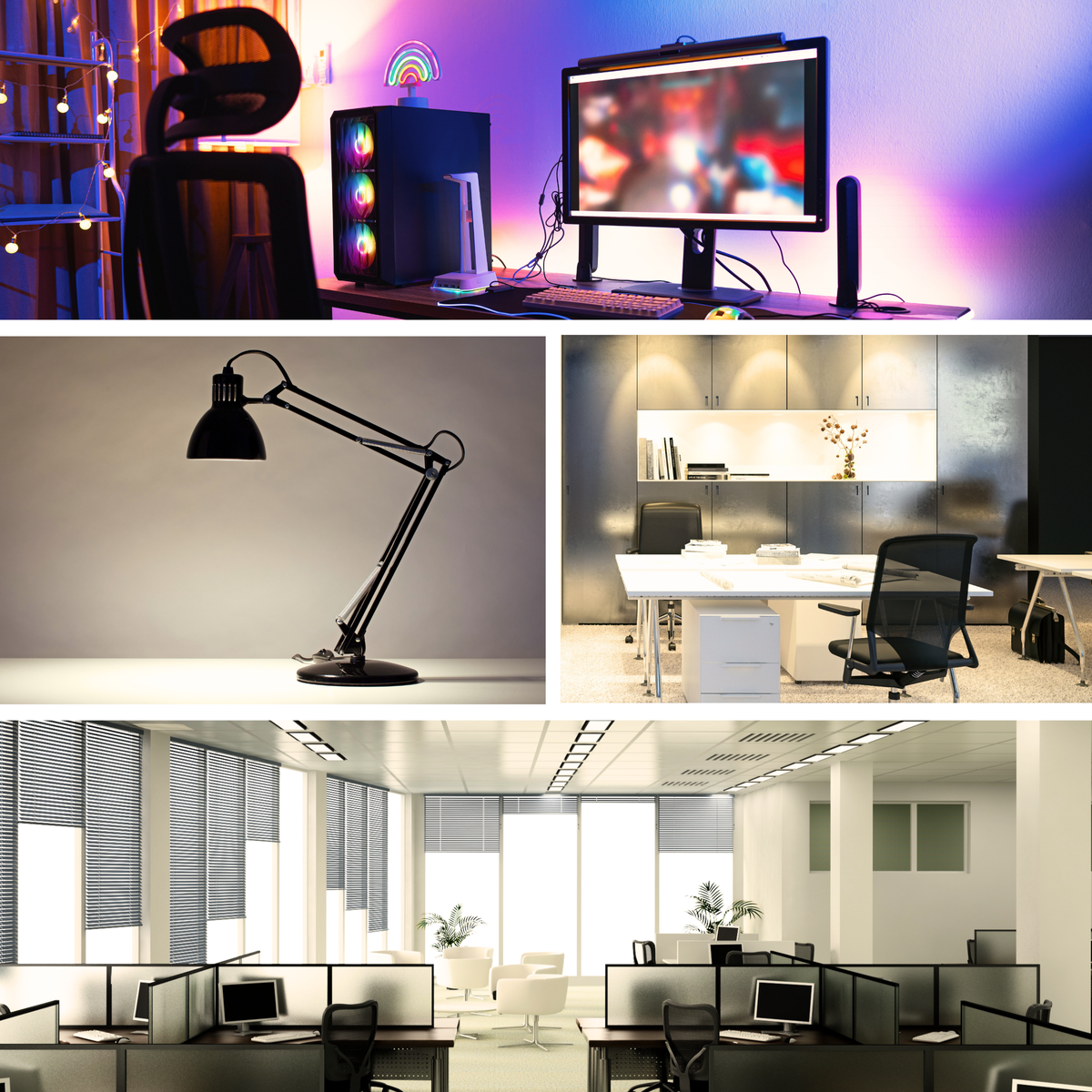Creating the perfect lighting for an office isn't just about aesthetics; it's a crucial component of a productive and healthy work environment. With so many options available, it can be challenging to determine the best lighting for your office space. This comprehensive guide will help you understand the various types of lighting and how to choose the right one for your needs.
Key Takeaways:
- Understanding the different types of office lighting is essential for creating a productive work environment.
- The right lighting can reduce eye strain and improve employee alertness and mood.
- LED lights are a popular and energy-efficient option for office spaces.
The Importance of Proper Office Lighting
When considering what lighting is best for an office, it's important to recognize the impact that light has on our daily work life. Good lighting can reduce eye strain, prevent fatigue, and even influence our sleep patterns. In contrast, poor lighting can lead to decreased productivity and a host of health issues. Therefore, finding the right office lighting is a major factor in creating a conducive work environment.
Natural Lighting: A Bright Idea
Natural lighting is often considered the gold standard for office environments. It not only provides a bright light that helps employees stay alert but also offers benefits that artificial lights cannot match, such as a connection to the outdoor environment and the regulation of sleep patterns. However, too much direct sunlight can cause glare and heat, so it's important to balance natural light with other lighting options.

Fluorescent Lights: A Common Choice
Fluorescent office lights, particularly fluorescent ceiling fixtures, have been a staple in office settings for decades. They provide a widely dispersed light source that can illuminate an entire office space efficiently. However, the blue light emitted by fluorescent bulbs can contribute to eye strain and may affect sleep patterns if used extensively towards the end of the day.
LED Bulbs: The Efficient Alternative
LED lights are becoming the best office lighting choice for many businesses due to their energy efficiency and long lifespan. LED bulbs can mimic natural daylight, which helps to maintain the body's natural circadian rhythm. Additionally, LED lights come in a variety of color temperatures, allowing for more control over the mood and atmosphere of the office.
The Role of Task Lights
Direct task lighting is essential in any office setting. Desk lamps and under-cabinet lighting provide light exactly where it's needed, minimizing shadows and reducing the need for overhead bulbs to be excessively bright. Task lights should be adjustable and positioned to avoid reflections on computer screens.
Ambient Lighting: Setting the Mood
Ambient lighting is the base layer of office lighting that provides a comfortable level of brightness without glare. This type of lighting often comes from overhead bulbs and should be soft enough to prevent harsh lighting conditions but bright enough to prevent eye strain. It's the foundation upon which task and accent lighting are added.

Accent Lighting: The Finishing Touch
Accent lighting is not typically a primary light source in office spaces but can be used to highlight artwork, plants, or architectural features. It adds depth to the space and can make an office feel more inviting. A strategically placed floor lamp or wall sconce can serve as accent lighting while contributing to the overall illumination of the space.
Smart Lighting Systems: Revolutionizing Office Illumination
In the quest for the best light for office environments, smart lighting systems are becoming increasingly popular. These systems offer unparalleled control over the lighting situation, allowing adjustments to be made for different times of the day or specific tasks. With features like motion sensors and the ability to dim or brighten lights through a smartphone app, smart lighting ensures a well-lit workspace without wasting energy. This adaptability not only enhances the working environment but also contributes to a more energy efficient office.
Moreover, smart lighting can automatically adjust the white light intensity to complement the natural light entering the space, reducing the reliance on office ceiling lights during the day. This dynamic adjustment helps in maintaining a consistent level of illumination, which is crucial for minimizing eye strain, especially when looking at computer screens or laptop screens. By integrating with other smart office devices, these systems can create an interconnected and responsive workspace that adapts to the needs of its users.
Ergonomic Lighting: Comfort Meets Productivity
When considering a well-lit workspace, ergonomic lighting should be at the forefront of design. This approach prioritizes the comfort and efficiency of the individual, reducing eye strain and improving focus. A desk lamp with adjustable brightness and color temperature can be a key element in ergonomic lighting. By allowing users to tailor the light intensity, they can create a direct light source that complements their specific tasks, whether it's reading, writing, or computer work. The flexibility of a desk lamp also means that as the day progresses and natural light changes, the workspace can remain consistently illuminated without causing discomfort.

Moreover, ergonomic lighting goes beyond just the functionality of a desk lamp. It encompasses the placement of light sources to minimize glare and shadows that can lead to visual fatigue. A well-planned lighting scheme takes into account the position of monitors, the user's line of sight, and the general layout of the office furniture. By doing so, it ensures that direct light enhances productivity without becoming a source of distraction or discomfort. As more offices adopt ergonomic principles, the focus on creating a harmonious lighting environment is becoming a key factor in workspace design.
Lighting Controls: Empowering Personal Preferences
In the quest for the perfect office lighting, the power of personalization cannot be underestimated. Lighting controls are an essential feature that allows individuals to adjust their environment to suit their preferences and needs. From dimmers on a desk lamp to smart systems that can be controlled via an app, these tools offer users the ability to create a well-lit workspace that adapts to their daily rhythms. For instance, one might prefer a brighter, more direct light in the morning to kickstart their day, while opting for a softer glow as the afternoon wanes to avoid overstimulation.

The benefits of lighting controls extend beyond personal comfort; they also contribute to energy efficiency. By using only the amount of light needed for a task, unnecessary energy consumption is reduced, leading to cost savings and a smaller carbon footprint. Additionally, with the integration of occupancy sensors and timers, lighting controls can ensure that lights are on only when needed, further enhancing the sustainability of the office. As technology advances, we can expect these controls to become even more intuitive, learning from our habits and preferences to provide an effortlessly well-lit workspace.
Biophilic Lighting Design: Mimicking Natural Environments
Biophilic design takes inspiration from nature to create a more organic and comfortable working environment. When it comes to lighting, this approach involves the use of widely dispersed light sources that mimic the variability and softness of natural light. Biophilic lighting strategies often employ indirect light to avoid harsh shadows and glare, which can be detrimental when working on tasks that require focus, such as reading from a computer screen.
Incorporating elements like fluorescent lighting that simulates daylight patterns or incandescent bulbs for their warm glow can help in achieving a balance between functionality and comfort. This balance is essential for a well-lit workspace that promotes well-being and productivity. By using biophilic principles, office lighting can create a sense of connection to the natural world, which has been shown to reduce stress and improve mood, making it a vital component of a modern, health-conscious office design.
The Debate: Cool Light vs. Warm Light
The temperature of light bulbs, measured in Kelvin, can affect the mood and energy levels of employees. Cool light, which is higher in blue light, is often recommended for office settings because it can help employees stay alert. However, warm light can create a more relaxing atmosphere, which may be beneficial in spaces designed for breaks or creative thinking.
Indirect Lighting: A Softer Approach
Indirect lighting, which involves bouncing light off ceilings and walls, can provide a more even light distribution and minimize shadows. This type of lighting can create a softer, more comfortable environment that's conducive to productivity. It's often used in combination with direct lighting for the best effect.
Energy Efficiency: Saving More Than Just Money
Energy-efficient lighting, such as LED bulbs, not only reduces the office's carbon footprint but also saves on energy costs. Additionally, features like motion sensors can further enhance energy savings by ensuring lights are only on when needed.

The Impact of Lighting on Health
The right office lighting can have a significant impact on the health of employees. Harsh lighting can lead to headaches and eye strain, while the right lighting can improve mood and even productivity. It's important to consider the health implications when choosing office lighting products.
Computer Placement and Lighting
The placement of computers in relation to light sources is crucial to prevent glare on screens. Laptops and computer screens should be positioned to avoid direct sunlight and should be complemented with task lighting to provide light without causing reflections.
Lighting Options for Different Tasks
Different tasks require different types of lighting. For instance, tasks that require attention to detail may benefit from bright, direct task lighting, while creative tasks may be better suited to a well-lit workspace with more ambient light. Understanding the lighting needs of various tasks can help in selecting the right office light fixtures.
Customizing Lighting for Individual Needs
Not all employees have the same lighting preferences or needs. Providing options like adjustable desk lamps or allowing employees to choose their bulb type can help create a more personalized work environment. This level of customization can lead to a more comfortable and productive workspace.

The Future of Office Lighting
As technology advances, so do office lighting options. Innovations like bulbs that emit less infrared radiation or lighting systems that can be controlled via smartphone are becoming more common. These advancements provide even more ways to create the perfect lighting for an office.
Summary
Choosing the right lighting for an office is a critical decision that affects the well-being and productivity of employees. From natural lighting to LED bulbs, each type of lighting offers unique benefits and challenges. By considering factors such as energy efficiency, health implications, and the specific needs of different tasks, businesses can create an office environment that is both comfortable and conducive to work.
FAQ Section
Q: What is the best type of lighting for reducing eye strain in an office?
A: LED lights that mimic natural daylight are generally the best for reducing eye strain, as they provide bright, even light without the flicker associated with fluorescent bulbs. Task lighting can also help by providing focused light where it's needed most.
Q: How does office lighting affect productivity?
A: Proper office lighting can improve productivity by reducing eye strain, preventing fatigue, and helping to maintain regular sleep patterns. Bright light, particularly in the cooler spectrum, can help employees stay alert and focused.
Q: Are there any health benefits to using natural lighting in an office?
A: Yes, natural lighting can help regulate sleep patterns, improve mood, and reduce the need for artificial lighting, which can sometimes emit harmful blue light. However, it's important to balance natural light with other lighting types to prevent glare and overheating.










